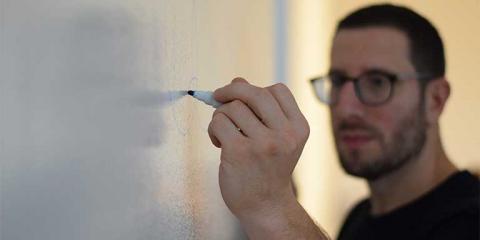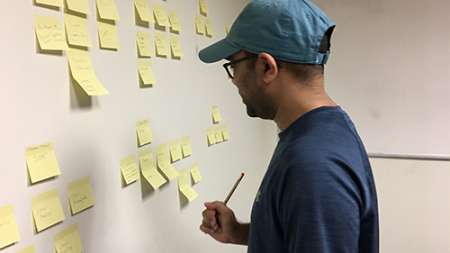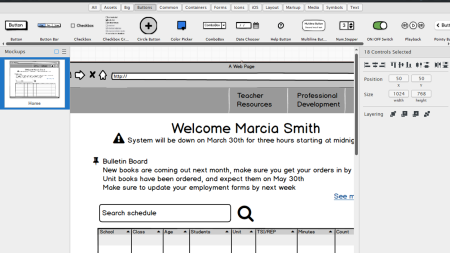
Related Class
What is rapid prototyping for UX
- Published on

Rapid prototyping for UX is an iterative approach to the development of the UX or UI of websites or software applications. Rapid prototyping involves quickly creating mock-ups of a system before it is built in production. This allows for the UX or UI to be validated by prospective users and other stakeholders before it is put into full-scale production. The idea behind rapid prototyping is that it allows for better designs because feedback is received much earlier in the development process. Long-term development should also be more efficient because of prototyping, as fewer changes and updates are needed when fixes are addressed earlier in the planning process.
Rapid prototyping places more emphasis on quickly iterating designs to allow development to proceed more efficiently. Traditional methods of software development generally requires rigorous specifications whereas rapid prototyping attempts to use the knowledge gained during the design and development phase to adjust the software. Various kinds of prototyping and their processes are covered in user experience courses.
Rapid Prototyping Process
Rapid prototyping for UX can be used in addition to the process of creating design specifications, or may even completely replace the specification process. User interfaces are especially well-suited to rapid prototyping because they are primarily driven by user requirements. Rapid prototyping, and its close cousin, Rapid Application Development (RAD), allow for a fast approach to creating a prototype of a new site or app, or incremental version for an existing one that is being updated.
Create the Prototype: Initially the prototype can start as a quick mock-up, which can be as simple as a pencil sketch. Prototypes can become more elaborate and involve more details as they progress.
Share and Review: The purpose of a prototype is to gain feedback, which occurs at this stage of the process. Users and stakeholders can provide feedback as to whether the prototype will meet their needs.
Revise the Protype: Prototypes that are made quickly should be considered expendable. This allows for changes to be made without anyone feeling as though they had invested too much into them, limiting a desire to make changes and updates. The purpose of obtaining feedback is to determine what revisions are needed. Iterations can be real-time, or made within hours or days. The idea is to quickly produce revisions based upon user feedback.
Requirements Planning for Rapid Prototyping
The requirements planning phase includes determining. UX Designers, developers, business analysts, managers, and stakeholders agree on the business requirements, constraints and project scope during this phase.
With rapid prototyping, the questions of what needs to be prototyped, including how much of the interface and process should be included are then determined.
Creating a Scenario: Create stories that describe when users will be working with your app, and what these users needs will be. This allows you to attempt to create prototypes that meet their needs
Iterating the UX: Start simply by creating low fidelity prototypes. Don’t focus on the content or even the design. Instead pay attention to usability and user flow. You do not need or want actual content or higher fidelity designs until the early prototypes have been validated. As the prototypes become more refined and high fidelity, you may consider using any one of a number of UX testing tools.
Prototyping Tools: You may want to start with pencil and paper, and can move on to use any one of a variety of available prototyping tools.
Learning More about Rapid Prototyping for UX
If you want to learn more about this process, you can take a rapid prototyping training course, or any of the series of user experience classes available at AGI. These classes can be taken individually or as part of the UX certificate program or UX bootcamp.
About the author
Jennifer Smith is a user experience designer, educator and author based in Boston. She has worked in the field of user experience design for more than 15 years.She has designed websites, ecommerce sites, apps, and embedded systems. Jennifer designs solutions for mobile, desktop, and iOT devices.
Jennifer delivers UX training and UX consulting for large Fortune 100 companies, small start-ups, and independent software vendors.She has served as a Designer in Residence at Microsoft, assisting third-party app developers to improve their design solutions and create successful user experiences. She has been hired by Adobe and Microsoft to deliver training workshops to their staff, and has traveled to Asia, Europe, India, the Middle East, and across the U.S. to deliver courses and assist on UX design projects. She has extensive knowledge of modern UX Design, and worked closely with major tech companies to create educational material and deliver UX workshops to key partners globally. Jennifer works with a wide range of prototyping tools including XD, Sketch, Balsamiq, Fireworks, Photoshop, Illustrator, and Blend for Visual Studio. She also works extensively in the fields of presentation design and visual design.
Jennifer is also an expert on Photoshop, digital image editing, and photo manipulation. Having written 10 books on Photoshop, and having consulted and provided training to major media companies and businesses around the globe.
Jennifer is the author of more than 20 books on design tools and processes, including Adobe Creative Cloud for Dummies, Adobe Creative Cloud Digital Classroom, and Photoshop Digital Classroom. She has been awarded a Microsoft MVP three times for her work with user experience design in creating apps for touch, desktop, and mobile devices. Jennifer holds the CPUX-F certification from the User Experience Qualification Board and assists others in attaining this designation in leading a UX certification course at American Graphics Institute. She is a candidate for a Master’s degree in Human Factors in Information Design.


